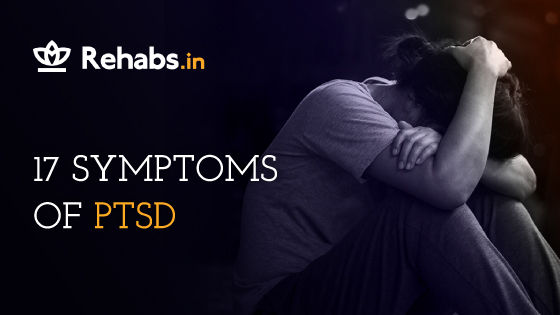17 symptoms of PTSD

What are the 17 symptoms of PTSD?
Explore the 17 symptoms of PTSD. Understand the emotional, psychological, and physical signs of post-traumatic stress disorder and its impact on individuals.
What are the 17 symptoms of PTSD?
Post-Traumatic Stress Disorder (PTSD) is a mental health condition that can manifest within a month following a traumatic event, though some symptoms may not surface until years later. These symptoms can significantly impact your personal, social, work-life, and relationships, making it challenging to carry out your daily routines.
According to the National Center for PTSD, in India, approximately 60% of men and 50% of women encounter at least one traumatic event in their lifetime. The upcoming article will delve into the 17 PTSD symptoms, assisting in identifying them and discussing treatment approaches.
- Agitation
In diagnosing PTSD, physicians typically seek out three or four specific symptoms, one of which is agitation. The presence of anger is often closely intertwined with PTSD and is considered a symptom of heightened arousal associated with the condition.
The immediate reactions of irritability and agitation among individuals with PTSD can give rise to significant challenges, both in the workplace and in their personal lives. Over time, these elevated levels of agitation and arousal can become the individual’s usual state, leaving them feeling constantly on edge, highly alert, and easily provoked.
Learning how to cope with this agitation can be particularly challenging for those who endured traumatic events during childhood. This difficulty can lead to a heightened sense of vulnerability, causing individuals to adopt aggressive behaviours as a means of self-protection and control over their surroundings. Unfortunately, this inflexibility in their interactions may, in turn, elicit hostile responses from others.
- Nervousness and anxiety
Feeling anxious or nervous is a common experience for anyone. When we perceive a threat, our bodies activate the “Fight or Flight” response. Sudden and persistent anxiety is indicative of PTSD symptoms, and in cases of complex PTSD, anxiety can be severely debilitating.
Individuals with PTSD may undergo intense anxiety attacks and feelings of nervousness when exposed to triggers that remind them of past traumas. These experiences give rise to a range of physical, psychological, and emotional symptoms associated with anxiety and panic.
Even without experiencing flashbacks, the memories of trauma can inundate a person, as they remain vivid and emotionally evocative. Anxiety symptoms can bring forth a flood of unwanted emotions and unpleasant physical sensations. However, it’s important to note that reaching a panic stage as a result of anxiety typically occurs after prolonged exposure to trauma, leading to the development of PTSD.
- Problems with concentration or thinking
Experiencing trauma can have diverse effects on both your mind and body. When you encounter symptoms like brain fog and a slowed mental state, it becomes challenging to maintain clear thinking, and these are recognised as symptoms of PTSD.
PTSD exerts its influence on several areas of the brain, with a particular impact on the amygdala and the pre-frontal cortex. In the presence of PTSD symptoms, these brain regions operate differently. The amygdala can become overly sensitive, while the pre-frontal cortex operates at a reduced capacity, resulting in difficulties with clear thinking.
PTSD can also give rise to attention-related issues, making it challenging to concentrate on information. Distractions may easily divert your focus, making it difficult to stay engaged in tasks. This difficulty in concentrating often stems from being preoccupied with trauma-related thoughts and persistent concerns about potential threats.
- Problems with memory
Individuals with PTSD often encounter alterations in various aspects of their memory, encompassing both long-term and short-term memory. Recent research in 2022 has highlighted two fundamental ways in which PTSD can impact memory.
Firstly, it can influence a person’s recollection of traumatic events, potentially leading to vivid flashbacks or difficulties in recalling those memories. Secondly, it can affect general memory functions, resulting in increased forgetfulness and challenges with both short-term and long-term memory.
This effect of PTSD on memory can be attributed, in part, to the alterations trauma can induce in specific brain regions associated with stress responses and memory, including the amygdala, hippocampus, and prefrontal cortex.
As trauma and conditions like PTSD can influence these critical brain areas essential for human memory, it provides insight into why individuals with PTSD often experience changes in memory formation, recall, and working memory.
- Headaches
The precise reasons behind the increased likelihood of headaches in individuals with PTSD remain unclear to researchers. However, one contributing factor could be the tension experienced in the head and neck regions due to elevated stress levels. Some post-traumatic headaches closely resemble migraines.
In cases where post-traumatic headaches resemble tension-type headaches, the symptoms are typically mild to moderate. These headaches lack the pulsing pain, nausea, or vomiting commonly associated with migraines, but they may exhibit sensitivity to light or sound. If these headaches persist, seeking professional assistance is advisable.
Studies have shown that individuals experiencing migraines or tension headaches frequently report substantial exposure to traumatic events. Additionally, there is a 17% correlation between consistent symptoms and a diagnosis of PTSD. Another study discovered that 32% of veterans from Afghanistan and Iraq (OEF/OIF) who have PTSD also report experiencing issues with headaches.
- Depression and crying spells
Depression frequently arises following a traumatic experience. Research findings from a comprehensive national survey have indicated that individuals with PTSD are approximately three to five times more prone to experiencing depression compared to those who do not have PTSD.
Numerous symptoms of depression bear similarities to those of PTSD. For instance, individuals dealing with both depression and PTSD may encounter difficulties in sleeping or maintaining concentration. They might lose interest in activities they once found enjoyable and become less inclined to socialise with others.
PTSD and depression frequently display heightened irritability, and it’s entirely possible for an individual to contend with both conditions simultaneously.
- Suicidal thoughts or attempts
PTSD can envelop you in an overwhelming sense of being trapped in the aftermath of your experiences. The constant onslaught of reminders and flashbacks can exact a toll as your brain attempts to cope with these memories in its own way.
Living with PTSD can heighten the risk of contemplating or attempting suicide. A review of research conducted in 2021 examining suicide rates among U.S. veterans and active service members who served in post-9/11 conflicts revealed that PTSD contributed to a suicide rate four times higher than any other military combat-related fatalities.
Discussing PTSD and thoughts of suicide is often challenging. If you or someone you care about is grappling with suicidal thoughts linked to PTSD, seeking help immediately is of utmost importance.
- Mood swings
Individuals dealing with PTSD frequently grapple with intense and unfamiliar emotions that are challenging to discern, appearing as though they are uncontrollable and unpredictable. It’s essential to recognise that humans are not inherently equipped with the ability to manage their emotions.
Nonetheless, when traumatic experiences occur during childhood or adolescence, they can disrupt this natural emotional regulation process, leading to difficulties in comprehending and controlling one’s emotions. Such trauma can induce intricate alterations in the brain, significantly affecting emotional development.
- Obsessive-compulsive tendencies
Obsessions refer to persistent, distress-inducing, and uncontrollable thoughts. Compulsions, on the other hand, encompass repetitive behaviours or mental actions that one may feel compelled to perform in response to these obsessions.
Individuals contending with both PTSD and Obsessive Compulsive Disorder (OCD) may grapple with intrusive thoughts and engage in neutralising actions. It’s understandable that someone who has undergone a traumatic experience might persistently experience anxiety, leading them to employ compulsive behaviours in search of comfort.
Behavioural patterns influenced by PTSD often revolve around the desire to avert the reoccurrence of traumatic triggers. This can encompass perfectionist behaviours or rituals that provide a sense of relief, assuring them that they have effectively mitigated or minimised the risk of trauma resurfacing.
- Panic episodes
Over a third of individuals who experienced panic attacks showed indications of panic-attack-related post-traumatic stress disorder. People dealing with PTSD frequently grapple with concurrent symptoms, and it’s not unusual for them to exhibit episodes of panic.
Individuals encountering panic attacks often develop a heightened fear just at the thought of the next impending attack. This fear prompts them to avoid locations they associate with potential attacks, establishing a safety zone that restricts their exposure to areas where they believe panic attacks are less likely to happen.
- Paranoia
Although paranoia is typically not recognised as a symptom of PTSD, it can frequently stem from the emotions evoked by trauma. An individual experiencing paranoia tends to harbour suspicions about others, believing that they may have harmful intentions.
A study explored the connection between paranoia and PTSD in individuals who had undergone assault. The researchers observed that 80% of the participants exhibited an intensified fear of others, which is a fundamental characteristic of paranoia.
- Shakiness
When you find yourself in highly stressful situations, your response can manifest in various forms. Some of these responses are emotional or psychological, while others are physical. One common physical reaction is the occurrence of bodily tremors or shakiness. Individuals with PTSD often experience symptoms that intensify when triggered or confronted with specific circumstances.
Typically, tremors or shakiness are regarded as symptoms associated with conditions like PTSD. Nevertheless, research suggests an alternative perspective. Instead of merely serving as symptoms, they can be interpreted as your body’s way of managing the effects of trauma.
Through these tremors, your system may attempt to alleviate some of the muscle tension stemming from prolonged stress. In doing so, it may contribute to the release of stored trauma in your body, ultimately reducing muscle strain.
- Substance abuse
PTSD induces changes in brain chemistry similar to those observed in cases of substance abuse and addiction. Individuals seeking treatment for PTSD have a significantly elevated risk, being 14 times more likely to receive a diagnosis of a substance use disorder as well.
An attempt to self-medicate often serves as a contributing factor to why many individuals with PTSD also engage in substance misuse. This behaviour is rooted in the belief that the use of substances can help nullify or alleviate the symptoms of PTSD. Those dealing with both PTSD and substance abuse are more inclined to misuse alcohol rather than other drugs.
Individuals with PTSD may resort to the consumption of alcohol and other mood-enhancing substances, as these can elevate endorphin levels. Over time, they might develop a dependency on these substances to mitigate feelings of depression, anxiety, and irritability.
- Flashbacks
A flashback can mimic the recurrence of a traumatic event, and this occurrence is prevalent among individuals with PTSD. These flashbacks are typically temporary, allowing for some degree of connection with the present moment.
It’s important to note that not all individuals diagnosed with PTSD encounter flashbacks. For some, experiencing PTSD flashbacks is akin to a form of dissociation. This mental state results in a sensation of disconnection from one’s thoughts, emotions, memories, or sense of identity.
It’s worth emphasising that not every flashback entails a complete re-experiencing of the traumatic event from start to finish. In some cases, individuals may re-encounter certain elements of the event, while in others, only emotions or physical sensations are rekindled.
- Hypervigilance
Hypervigilance represents a heightened state of alertness. When in this condition, individuals become acutely sensitive to their surroundings, and it is often considered one of the symptoms associated with PTSD. Hypervigilance involves a constant search for concealed threats, whether they are real or perceived, and it can lead to profound exhaustion.
Some of the physical manifestations may resemble symptoms of anxiety, such as sweating, a rapid heart rate, and shallow or fast breathing. Behavioural indicators may encompass twitchy reflexes and swiftly instinctive responses to one’s environment. On a cognitive level, hypervigilance can give rise to symptoms of paranoia.
- Nightmares
The occurrence of PTSD-related nightmares appears to be more prevalent among individuals concurrently dealing with anxiety or panic disorders. These nightmares can happen multiple times per week and have the potential to cause considerable distress and disrupt not only the affected individual’s sleep but also that of others in the household. Research from 2018 implies that the most intense dream activity tends to coincide with the brain’s processing of emotionally charged experiences.
During nighttime, memories can materialise as troubling dreams or nightmares in which the traumatic event is revisited. This may result in an elevated state of arousal, making an individual more responsive to their surroundings. Some studies propose that genetic factors affecting the transmission of serotonin, a neurotransmitter in the brain, may play a role in influencing the development of PTSD.
- Sleep disturbances
Individuals who undergo a traumatic event and subsequently contend with substantial sleep issues seem to have an increased risk of developing PTSD later on. Strikingly, one of the initial indicators of PTSD is disturbances in sleep, often encompassing the presence of nightmares, insomnia, and disrupted rapid eye movement (REM) sleep patterns.
The sleep-related problems associated with PTSD hinder the brain’s capacity to effectively process memories and emotions, consequently impeding the recovery process following a traumatic event. Furthermore, it is noteworthy that many individuals with PTSD turn to alcohol or other substances in an attempt to improve their sleep quality.
Diagnosis and Assessment
In 2013, the American Psychiatric Association (APA) made revisions to the diagnostic criteria for PTSD in the fifth edition of its Diagnostic and Statistical Manual of Mental Disorders (DSM-5). These criteria are applicable to adults, adolescents, and children aged six years and older. To receive a diagnosis of PTSD, the following conditions must be met:
- Exposure to a traumatic event
- Presence of one or more intrusion symptoms
- Manifestation of one or more avoidance symptoms
- Display of two or more symptoms related to negative changes in feelings and mood
- Demonstration of two or more symptoms associated with changes in arousal or reactivity
- Additionally, these symptoms must endure for a duration exceeding one month and result in substantial distress and/or significant interference with various aspects of daily life. It is essential to note that these criteria can only be determined by a mental health professional, and it is imperative to seek their expertise for an accurate assessment and diagnosis of the condition.
Coping and Treatment
Living with PTSD may give you the impression that your life is irrevocably altered, but it’s important to understand that effective treatment options are available. Both short-term and long-term psychotherapy, in combination with medications, have shown significant efficacy. The American Psychiatric Association’s Clinical Practice Guideline strongly recommends four therapeutic approaches for addressing posttraumatic stress disorder:
- Cognitive Behavioral Therapy (CBT)
- Cognitive Processing Therapy (CPT)
- Cognitive Therapy
- Prolonged Exposure
It’s worth noting that, at present, the U.S. Food and Drug Administration (FDA) has not approved any specific medications for the direct treatment of PTSD. Nevertheless, healthcare professionals may prescribe certain medications to alleviate particular symptoms associated with PTSD, such as antidepressants or anti-anxiety medications.
Seeking Help
Now that we are aware of the 17 PTSD symptoms, it’s evident that this condition can impact individuals who have experienced any type of abuse, trauma, or life-threatening circumstance, regardless of whether they are veterans, accident survivors, or survivors of incest. Part of the PTSD symptoms is to avoid thinking about the trauma as they may have to talk about the events during the treatment.
Therapy can be beneficial even if your trauma occurred in the past. Additionally, treatment for PTSD has significantly improved over the years. There have been evidence-based treatments that can free you from the chains of debilitating mental health concerns.
There have been several trauma rehabs in India spread across the nation to provide easy access to everyone. Some of the rehab centres are based out of Lucknow, Delhi, Hyderabad, Nagpur, and Mumbai. These rehab centres exist to help people from all over India find relief and treatment for their disorders.
Sources:
- Alderton, M. (2021, November 10). PTSD & Brain Fog. The Trauma Practice. https://traumapractice.co.uk/ptsd-brain-fog/
- American Psychological Association. (n.d.). Treatments for PTSD. American Psychological Association. https://www.apa.org/ptsd-guideline/treatments
- Best Drug & Alcohol Rehab Centres in India. Rehabs.in. (2023, August 21). https://rehabs.in/
- Brandon Peters, M. (2022, October 27). Causes and treatment of nightmares in people with PTSD. Verywell Health. https://www.verywellhealth.com/the-causes-and-treatment-of-ptsd-nightmares-3014688#citation-3
- Diagnostic and statistical manual of mental disorders. DSM Library. (n.d.). https://dsm.psychiatryonline.org/doi/book/10.1176/appi.books.9780890425596
- Dibdin, E. (2022, September 7). Emotional dysregulation and PTSD: The role of childhood trauma. Psych Central. https://psychcentral.com/ptsd/affect-dysregulation-and-c-ptsd#next-steps
- Eichenlaub, J.-B., van Rijn, E., Gaskell, M. G., Lewis, P. A., Maby, E., Malinowski, J. E., Walker, M. P., Boy, F., & Blagrove, M. (2018). Incorporation of recent waking-life experiences in dreams correlates with frontal theta activity in REM sleep. Social Cognitive and Affective Neuroscience, 13(6), 637–647. https://doi.org/10.1093/scan/nsy041
- Evidence-based treatment explained – a comprehensive guide. Rehabs.in. (2021, March 2). https://rehabs.in/learn/evidence-based-treatment/
- Gillette, H. (2022, March 25). PTSD and suicide: What’s the connection? Psych Central. https://psychcentral.com/ptsd/ptsd-suicide#getting-help
- GoodRx. (n.d.). What PTSD flashbacks feel like (and how to stop them). GoodRx. https://www.goodrx.com/conditions/ptsd/ptsd-flashback
- Gotter, A. (2018, August 23). Hypervigilance: Symptoms, causes, and treatment. Healthline. https://www.healthline.com/health/hypervigilance#treatment
- How post-traumatic stress disorder affects sleep. Sleep Foundation. (2023, September 22). https://www.sleepfoundation.org/mental-health/ptsd-and-sleep#references-79258
- Katharina Star, P. (2020, July 20). The differences between panic disorder and PTSD. Verywell Mind. https://www.verywellmind.com/panic-disorder-and-ptsd-2584231
- KJ;, N. S. (n.d.). Genetics of anxiety and trauma-related disorders. Neuroscience. https://pubmed.ncbi.nlm.nih.gov/19540311/
- Lockett, E. (2023, March 24). Can PTSD cause memory loss or forgetfulness?. Healthline. https://www.healthline.com/health/mental-health/memory-loss-and-ptsd#causation
- Lovering, N. (2022, September 20). Ptsd brain fog: Causes, symptoms, and treatment. Psych Central. https://psychcentral.com/ptsd/ptsd-brain-fog#coping-with-brain-fog
- Matthew Tull, P. (2021, March 22). How and why you should increase your emotional awareness. Verywell Mind. https://www.verywellmind.com/increasing-emotional-awareness-2797603
- Matthew Tull, P. (2022, June 27). Why your PTSD and migraines might be related. Verywell Mind. https://www.verywellmind.com/the-association-between-ptsd-and-headaches-2797467#:~:text=PTSD%20can%20significantly%20interfere%20with,increase%20the%20likelihood%20of%20headaches.
- Matthew Tull, P. (2023, March 16). Flashbacks and dissociation in PTSD: How to cope. Verywell Mind. https://www.verywellmind.com/coping-with-flashbacks-2797574
- Matthew Tull, P. (n.d.). PTSD criteria, causes, and treatment. Verywell Mind. https://www.verywellmind.com/ptsd-in-the-dsm-5-2797324
- MR;, P.-S. E. A. (n.d.). Sleep and REM sleep disturbance in the pathophysiology of PTSD: The role of Extinction Memory. Biology of mood & anxiety disorders. https://pubmed.ncbi.nlm.nih.gov/26034578/
- Norrholm SD, Ressler KJ. Genetics of anxiety and trauma-related disorders. Neuroscience. 2009;164(1):272–287. doi:10.1016/j.neuroscience.2009.06.036
- Patrick McGrath, P. (2023, July 19). Can your PTSD trigger OCD?. NOCD. https://www.treatmyocd.com/blog/can-ptsd-trigger-ocd
- Pitts, B. L., Eisenberg, M. L., Bailey, H. R., & Zacks, J. M. (2022, April 25). PTSD is associated with impaired event processing and memory for everyday events. Cognitive research: principles and implications. https://www.ncbi.nlm.nih.gov/pmc/articles/PMC9038970/
- Post-traumatic stress disorder (PTSD) & addiction: Symptoms & treatment. American Addiction Centers. (2023a, July 24). https://americanaddictioncenters.org/co-occurring-disorders/ptsd-addiction
- Post-traumatic stress disorder and addiction. Addiction Center. (2023, May 8). https://www.addictioncenter.com/addiction/post-traumatic-stress-disorder/
- professional, C. C. medical. (n.d.). PTSD (post-traumatic stress disorder): Symptoms & treatment. Cleveland Clinic. https://my.clevelandclinic.org/health/diseases/9545-post-traumatic-stress-disorder-ptsd
- PTSD and anxiety. BrightQuest Treatment Centers. (n.d.). https://www.brightquest.com/post-traumatic-stress-disorder/ptsd-and-anxiety/
- Recovery, E. I. H. and. (2023, March 24). Neurogenic tremors. Emerald Isle Health & Recovery. https://emeraldislehealthandrecovery.com/2021/12/02/neurogenic-tremors/
- Team, B. E. (2023, July 12). Paranoia and PTSD: Are they linked?. BetterHelp. https://www.betterhelp.com/advice/ptsd/are-ptsd-paranoia-linked/
- The benefits of seeking help if you have PTSD. The Benefits of Seeking Help If You Have PTSD: The Soho Center for Mental Health Counseling: Psychotherapists. (n.d.). https://www.thesohocenter.com/blog/the-benefits-of-seeking-help-if-you-have-ptsd
- The Watson Institute for International and Public Affairs. (n.d.). https://watson.brown.edu/costsofwar/files/cow/imce/papers/2021/Suitt_Suicides_Costs%20of%20War_June%2021%202021.pdf
- Trauma archives. Rehabs.in. (n.d.). https://rehabs.in/services/trauma/
- Va.gov: Veterans Affairs. Anger and Trauma. (2018, August 3). https://www.ptsd.va.gov/understand/related/anger.asp#:~:text=If%20you%20have%20PTSD%2C%20this,You%20may%20be%20easily%20provoked
- Va.gov: Veterans Affairs. Depression, Trauma, and PTSD. (2018, August 3). https://www.ptsd.va.gov/understand/related/depression_trauma.asp#:~:text=Many%20symptoms%20of%20depression%20overlap,with%20other%20people%20as%20much
- Va.gov: Veterans Affairs. How Common is PTSD in Adults? (2018, September 13). https://www.ptsd.va.gov/understand/common/common_adults.asp
- Va.gov: Veterans Affairs. Suicide and PTSD. (2007, January 1). https://www.ptsd.va.gov/understand/related/suicide_ptsd.asp
- WebMD. (n.d.). What is post-traumatic headache?. WebMD. https://www.webmd.com/migraines-headaches/what-is-post-traumatic-headache
- What is a substance use disorder (SUD)?. American Addiction Centers. (2023b, August 14). https://americanaddictioncenters.org/rehab-guide/substance-use-disorder
- Why get treatment? – PTSD: National Center for PTSD. (n.d.). https://ptsd.va.gov/PTSD/understand_tx/why_tx.asp













